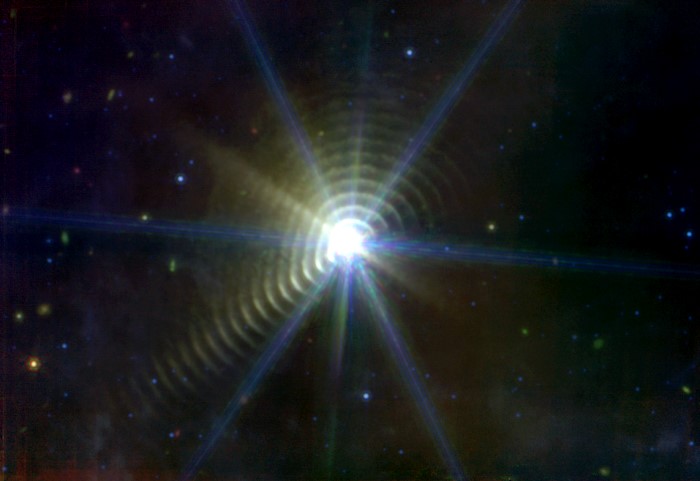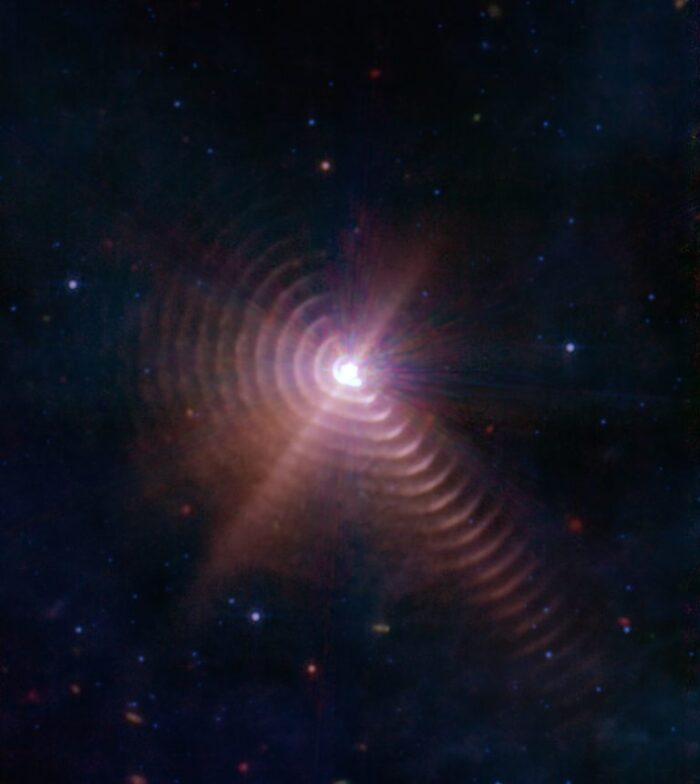Though it hasn't even been working for a full year yet, the James Webb Space Telescope (JWST) has already changed so much of how we're seeing space.
Some of this has been due to new discoveries. But just as enlightening has been how it has brought greater detail to things that we were already aware of.
The case of WR 140 is one of those things. This is a binary star—two stars that are orbiting each other closely. That is already pretty cool, but what makes WR 140 really special is that it is a 'colliding wind' binary. This means that at certain points in their orbits around each other, the two stars get close enough to create a massive burst of space dust that gets illuminated by their combined light.
That is what you're seeing in the exceptional photo at the top of the post. We encourage you to go back and look at it again!
And now that you have, let's try and understand what is going on there.
Two bright, hot heads

Another version of the WR 140 image, but with the diffraction spikes (those blue lines of light) still in the picture. (NASA/JPL-Caltech)
WR 140 is made up of an enormous blue supergiant and a smaller, rarer Wolf-Rayet star. Both of these stars are very hot and very bright.
The supergiant is one of the shortest lived star types in the universe (it lives 'only' a few million years instead of many billion, like our own Sun). Meanwhile, the Wolf-Rayet is very old and near the end of its life.
Enough though they are very different sizes and ages, they are both burning through their fuel at a rapid rate, which adds to this amazing spectacle. Even for stars, they are giving off tons of electromagnetic radiation, or light!
And this creates impressive stellar winds.
Windy days
Winds might sound like an odd thing in space, but these ones are very common. Our own Sun's solar winds are being sent toward Earth everyday. The collision of solar particles with our atmosphere is what causes the aurora borealis and australis, for example.
In the case of WR 140, the stellar winds are extremely strong because of how hot both stars are. And these powerful forces really reach a peak at one point in their orbits. The periastron (say peh-REE-ahs-trahn).
That's not a common word, but its meaning is easy to understand. It is the point in an elliptical (oval and elongated) orbit where the two stars are closest to each other. At the periastron, something explosive happens. The forces of the two stars 'blowing' out at each other cause a massive burst of dust to fly off from the supergiant. It's like someone blowing a hairdryer and at a pile of confetti.
This animation shows you what it's like.
Tree rings
That burst of dust in the video is what you're seeing in the JWST photo above. Cool, right? And there's something more...
The periastron of WR 140 happens every 7.94 years. Each time it does, this burst of space dust surrounds the stars like a shell expanding outwards. Now go back to the main image. How many shells of dust can you count?
Each one of those shells represents a moment in the past that the periastron happened. The older times are on the outside, the most recent are at the centre. This means that we can read the age of this event in WR 140 like rings on a tree. Astronomers estimate that this dust burst has been happening for around 160 years.
And the reason they can make this guess is because of the amazing new power of the James Webb. What an incredible device!
 Meet WR 140 and its remarkable dust rings. (NASA/JPL-Caltech)
Meet WR 140 and its remarkable dust rings. (NASA/JPL-Caltech)









